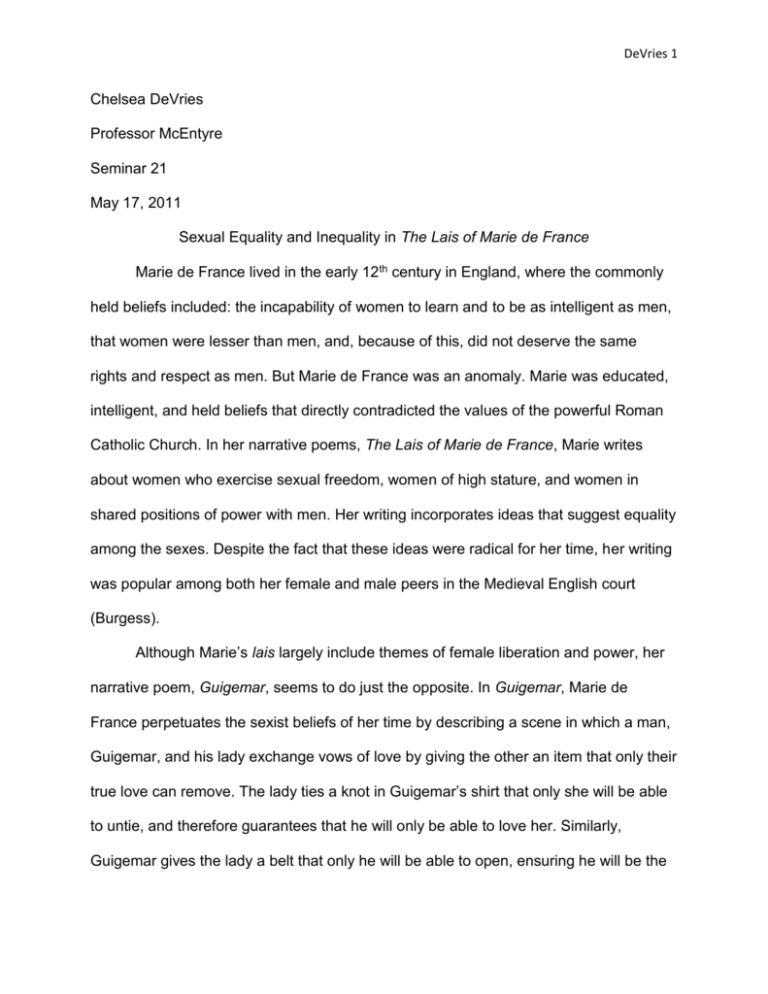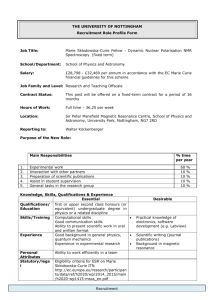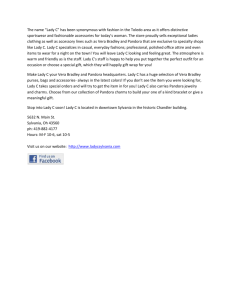
DeVries 1
Chelsea DeVries
Professor McEntyre
Seminar 21
May 17, 2011
Sexual Equality and Inequality in The Lais of Marie de France
Marie de France lived in the early 12th century in England, where the commonly
held beliefs included: the incapability of women to learn and to be as intelligent as men,
that women were lesser than men, and, because of this, did not deserve the same
rights and respect as men. But Marie de France was an anomaly. Marie was educated,
intelligent, and held beliefs that directly contradicted the values of the powerful Roman
Catholic Church. In her narrative poems, The Lais of Marie de France, Marie writes
about women who exercise sexual freedom, women of high stature, and women in
shared positions of power with men. Her writing incorporates ideas that suggest equality
among the sexes. Despite the fact that these ideas were radical for her time, her writing
was popular among both her female and male peers in the Medieval English court
(Burgess).
Although Marie’s lais largely include themes of female liberation and power, her
narrative poem, Guigemar, seems to do just the opposite. In Guigemar, Marie de
France perpetuates the sexist beliefs of her time by describing a scene in which a man,
Guigemar, and his lady exchange vows of love by giving the other an item that only their
true love can remove. The lady ties a knot in Guigemar’s shirt that only she will be able
to untie, and therefore guarantees that he will only be able to love her. Similarly,
Guigemar gives the lady a belt that only he will be able to open, ensuring he will be the
DeVries 2
only one that could “urge her to love” (l 576). Because the belt is a physical item that
wraps around her waist and not a symbolic enclosure that wraps around her heart, I
believe that the belt that Marie de France writes about is a sort of chastity belt that will
prohibit the lady from having sex. The relationship between Guigemar and his lady is
unequal, and Marie’s use of the words “tightened,” “flanks,” “breaking” and “severing”
indicate the greater burden the lady must bare because of the relationship than her
lover, Guigemar.
Marie continues on to perpetuate the inequality in the lady and Guigemar’s
relationship when she writes that the lady’s belt is “tightened about her flanks” (l 572).
Guigemar’s shirt is merely covering his upper body that, since he is a man, is often
exposed; it is not covering a private area of the body. Unlike Guigemar, the belt that the
lady wears covers her genitalia.
But the way in which these two individuals wear their items is very different. The
word “tightened” is synonyms with words like “constrict,” “rigid,” “constrain,” and
“unyielding” which stand in vivid contrast to the words that people may generally use to
describe a shirt such as “loose,” “light,” “soft,” and “comfortable.” Both must wear their
item, but the burden that the lady must bare while wearing her heavy belt is much
greater than the burden Guigemar carries when he dresses in his shirt. These burdens
not only represent the weight of each item, but of the weight each person carries in the
relationship. Whereas Guigemar can twice leave his lady to return home to his friends
and family in his native land, the lady must wait for Guigemar in isolation in a tower.
The Merriam-Webster dictionary defines the word “flank” as “the section of flesh
on the body of a person or animal between the last rib and the hip; the side. More
DeVries 3
commonly used in reference to an animal.” Marie describes the way the lady must wear
her item as if she is an animal whose sex drive needs to be controlled by a chastity belt.
An innate sexual urge lives within all of us, and Marie writes as if the lady, who is too
beastly to control her primal urge, must wear a belt around her flank to control and
regulate this urge. Perhaps this description would seem less extreme or severe if it
weren’t for the fact that Guigemar wears no belt around his genitalia. Guigemar’s animal
instincts are not being constrained by his love for his lady because his shirt is not
stopping him from having sex with another woman. Guigemar bares no burden or
constraint around his pelvic region, unlike his lady, who is being described like a rodeo
bull; an animal whose belt was painfully tightened around her flank.
Marie de France further highlights the inequality in Guigemar and the lady’s
relationship when she writes “whoever could open the buckle / without breaking it or
severing it from the belt / would be the one he would urge [the lady] to love” (ll 573-575).
The love the lady feels for Guigemar is much stronger than the love Guigemar has for
the lady, which is seen in the items that they carry with them. Unlike the knot in
Guigemar’s shirt that simply must be “undone” (l 562) or “untied” (l 565) in order for him
to love again, the lady’s belt is so strong and so tight that anyone trying to get past it
would likely “break” or “sever” it. The item that the lady must carry that represents her
love for Guigemar is something much stronger, tougher, and impenetrable than the item
Guigemar carries. Unlike a shirt that Guigemar has the option of removing and is light
enough to be swept away by the wind or mistakenly taken by another person, the lady’s
belt is a constant and permanent reminder of her love for Guigemar. The love the lady
DeVries 4
receives from Guigemar is not as strong as her own love, and the burden that places on
her can be seen in the discrepancy in the permanence of the lovers’ items.
While Marie de France’s work is largely written with themes that include sexual
equality and women in positions of power, it seems odd that she would write such a
sexist section in Guigemar. Perhaps a little too odd. Because Marie was a woman and
wrote her poems in both male dominated and controlled literary and general societies, is
it is possible that the sexist sections of her work were written merely to insure that her
work would be read? Perhaps Marie understood that even though she was an educated
member of the court, a piece of work that directly and outrageously contradicted the
social beliefs of the time, and had a female author, would not receive acknowledgement
from her peers and may even cause her to be punished. If this is true and Marie did add
sections to her work that reflected the early 12th century beliefs about women, Marie
could ensure that the most powerful people in England (her educated, noble, and
wealthy peers in court) would be more likely to read her work and help ensure its
endurance through time.
Marie seemed to understand the balance that exists between maintaining the
autonomy of her work, and the pressure to change her work in order to have it read by
larger audiences. Although Marie was writing close to a century ago, the artists in the
world today still feel a similar pressure. In the United States alone, filmmakers,
photographers, musicians and more are often pressured to edit or censor their work.
Filmmakers are often inadvertently forced to censor or edit their work in order to obtain
a desirable rating by the Motion Picture Association of America (MPAA). Although they
do not have to edit out the material that the MPAA deems to be “excessive sex,
DeVries 5
violence, or profanity,” film makers know that a movie rated “PG-13” will attract a larger
audience than a movie rated “R.” Similarly, photographers are often refused the honor
of having their work shown in some of the largest and most popular galleries in the
country because their work is deemed too indecent to be seen by the public. Robert
Mapplethorpe and his estate encounter this problem when galleries often ask them to
remove some of the more “erotic” photographs from his collection in order to have it
publically displayed. Musicians knows that the primary factor in determining their
album’s success is having their music played on the radio, but in order for this to
happen, they must create edited versions of their songs in which any words or phrases
deemed “indecent” by the Federal Communications Commission are removed.
If Marie did purposely add to her stories to make them more appealing to a larger
audience, it leads me to wonder if I would know about The Lais of Marie de France if
she had not. Will artists who choose not to edit or censor their work be just as popular
as if they did? Is it fair that people must often times create work that is appealing to the
general beliefs of the audience in order to gain success? Perhaps not, but in the time of
Marie de France and the world today, artists are too often still forced to choose between
autonomy and acknowledgment.
DeVries 6
Work Cited
Burgess, Glyn Sheridan. Marie de France: an analytical bibliography. London: Grant
and Cutler, 1977. Print.








